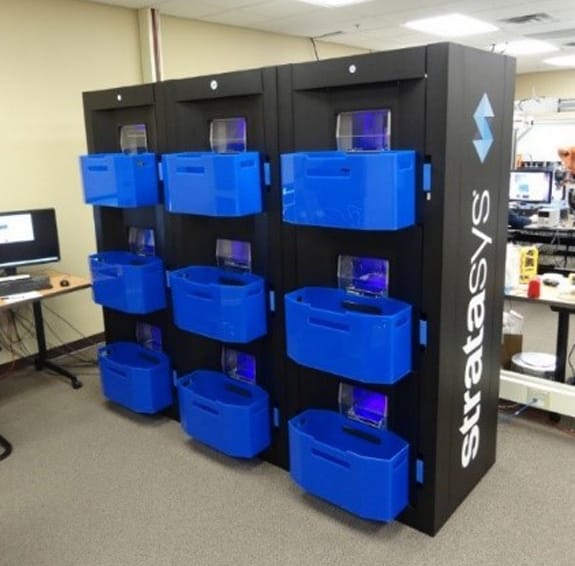
One of Stratasys’ two big announcements this week was a powerful array-style 3D printing system.
The “Stratasys Continuous Build 3D Demonstrator”, not be confused with the previously announced “Infinite Build Demonstrator”. The new concept involves ganging together a number of Fortus-like 3D printing “cells”, which can then be put to work in parallel on 3D print jobs. If you’re not aware, Fortus is Stratasys’ flagship line of production FDM (extrusion based 3D printers.
The current form of the demonstrator includes modules of three such printers stacked on one unit of floor space. The idea is to group them together in quantities to match the required capacity. So you might have what they call a “15 pack”, which would be five of these triplet machines together.
But this concept is far more than just a pile of printers. They offer significant automation.
The main feature is the print surface, modelled after their Fortus equipment. The Fortus machines use single sheet of clear plastic as the build surface, which is held down by means of a vacuum. A layer of model material is laid down first, permanently bonded with the sheet. Upon that is placed support material and then the model itself. The sheet is typically discarded after single use, unless large portions are unused.
The new demonstrator uses the same style of build sheet, except that it’s on a roll. When the print completes, the roll pushes out, where the printed portion is swiftly cut off with a blade and dropped into a detachable blue collection bin. Meanwhile a new portion of build sheet has been placed, ready for the next print.
In other words, these machines can unload themselves!
Imagine a 15 pack running continuously, with prints dropping every 20 minutes into one of those bins. The operator could show up once a day to collect them. And likely reload the input material spools, which would run out after many prints. Those parts could be identical, or, if leveraging 3D printing advantages, could each be unique. One current tester told us they had 3D printed 1200 keychains in only two days with their demonstrator!
There’s more.
Stratasys has also created sophisticated cloud-based software that controls the array. And get this – the array is not the whole array! The “array” is actually virtual array that can be composed of physically adjacent cells, or remote cells located elsewhere. Print jobs are input, routed and tracked “all the way to shipping”.
These arrays can get quite large, and have a correspondingly large capacity for making objects.
What they’re trying to do here is attempt a form of productionizing their 3D printing technology. Wait, you say, don’t they already have “Production” 3D printers? Well, yes, but where “Production” means “able to run reliably for long periods of time”. That kind of “production” still requires significant manual intervention.
Maybe a better term is “continuous”, as they say.
Another form of continuity in this concept is automated failover. Should a print job fail, it is detected and quickly re-routed to a free cell in the array for printing. The successful 3D printing of a part is more or less guaranteed with this concept.
Array 3D printing is not unique to Stratasys; we’ve seen something along the same lines from Mass Portal, Ultimaker and even Stratasys’ own MakerBot.
However, none of those arrays automatically unload themselves.
This is only a demonstrator concept, and definitely not a product, even though it’s been in use at at least three customer locations for some time, with apparently “tens of thousands of parts” being printed so far. The intention is for Stratasys to collect feedback regarding the usage of the system in order to develop a more complete future product. The build volume might change from the current 127 x 127 x 127mm to something else. Certainly the future product will need to 3D print more than just the single material available with this demonstrator. Therefore, there are no prices or availability for this system.
And there’s more required to “complete” a production system of this type. As I listened to their presentation many questions arose, such as “how does the operator keep track of the hundreds of items after they’re printed and washed?” Or “how are material or colour changes handled efficiently?” Or “could this system use gigantic filament spools?” And “what does a roll of build sheet material cost.
Those and other questions will no doubt be encountered, pondered and eventually solved by Stratasys.
Via Stratasys and BusinessWire

